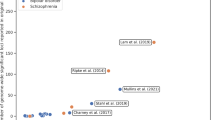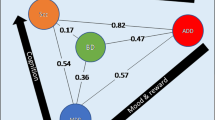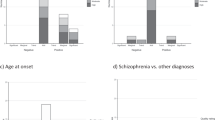Abstract
Bipolar disorder is a heterogenous condition with a varied clinical presentation. While progress has been made in identifying genetic variants associated with bipolar disorder, most common genetic variants have not yet been identified. More detailed phenotyping (beyond diagnosis) may increase the chance of finding genetic variants. Our aim therefore was to identify clinical characteristics that index genetic differences in bipolar disorder.
We performed a systematic review of all genome-wide molecular genetic, family, and twin studies investigating familial/genetic influences on the clinical characteristics of bipolar disorder. We performed an electronic database search of PubMed and PsycInfo until October 2022. We reviewed title/abstracts of 2693 unique records and full texts of 391 reports, identifying 445 relevant analyses from 142 different reports. These reports described 199 analyses from family studies, 183 analyses from molecular genetic studies and 63 analyses from other types of studies. We summarized the overall evidence per phenotype considering study quality, power, and number of studies.
We found moderate to strong evidence for a positive association of age at onset, subtype (bipolar I versus bipolar II), psychotic symptoms and manic symptoms with familial/genetic risk of bipolar disorder. Sex was not associated with overall genetic risk but could indicate qualitative genetic differences. Assessment of genetically relevant clinical characteristics of patients with bipolar disorder can be used to increase the phenotypic and genetic homogeneity of the sample in future genetic studies, which may yield more power, increase specificity, and improve understanding of the genetic architecture of bipolar disorder.
This is a preview of subscription content, access via your institution
Access options
Subscribe to this journal
Receive 12 print issues and online access
$259.00 per year
only $21.58 per issue
Buy this article
- Purchase on Springer Link
- Instant access to full article PDF
Prices may be subject to local taxes which are calculated during checkout

Similar content being viewed by others
References
Bienvenu OJ, Davydow DS, Kendler KS. Psychiatric ‘diseases’ versus behavioral disorders and degree of genetic influence. Psychol Med. 2011;41:33–40.
Johansson V, Kuja-Halkola R, Cannon TD, Hultman CM, Hedman AM. A population-based heritability estimate of bipolar disorder – In a Swedish twin sample. Psychiatry Res. 2019;278:180–7.
McGuffin P, Rijsdijk F, Andrew M, Sham P, Katz R, Cardno A. The heritability of bipolar affective disorder and the genetic relationship to unipolar depression. Arch Gen Psychiatry. 2003;60:497–502.
Gordovez FJA, McMahon FJ. The genetics of bipolar disorder. Mol Psychiatry. 2020;25:544–59.
Mullins N, Forstner AJ, O’Connell KS, Coombes B, Coleman JRI, Qiao Z, et al. Genome-wide association study of more than 40,000 bipolar disorder cases provides new insights into the underlying biology. Nat Genet. 2021;53:817–29.
Robinson PN. Deep phenotyping for precision medicine. Hum Mutat. 2012;33:777–80.
Weng C, Shah NH, Hripcsak G. Deep phenotyping: Embracing complexity and temporality—Towards scalability, portability, and interoperability. J Biomed Inf. 2020;105:103433.
Flint J. The genetic basis of major depressive disorder. Mol Psychiatry. 2023. 2023. https://doi.org/10.1038/s41380-023-01957-9.
O’Connell KS, Coombes BJ. Genetic contributions to bipolar disorder: current status and future directions. Psychol Med. 2021;51:2156–67.
Stahl EA, Breen G, Forstner AJ, McQuillin A, Ripke S, Trubetskoy V, et al. Genome-wide association study identifies 30 loci associated with bipolar disorder. Nat Genet. 2019;51:793–803.
CONVERGE consortium. Sparse whole-genome sequencing identifies two loci for major depressive disorder. Nature 2015;523:588–91.
Mitchell BL, Campos AI, Whiteman DC, Olsen CM, Gordon SD, Walker AJ, et al. The Australian Genetics of Depression Study: New Risk Loci and Dissecting Heterogeneity Between Subtypes. Biol Psychiatry. 2022;92:227–35.
Smoller JW, Finn CT. Family, Twin, and Adoption Studies of Bipolar Disorder. Am J Med Genet - Semin Med Genet. 2003;123 C:48–58.
MacQueen GM, Hajek T, Alda M. The phenotypes of bipolar disorder: relevance for genetic investigations. Mol Psychiatry. 2005;10:811–26.
Scott K, Nunes A, Pavlova B, Meier S, Alda M. Familial traits of bipolar disorder: A systematic review and meta-analysis. Acta Psychiatr Scand. 2023;148:133–41.
Fanous AH, Kendler KS. Genetic heterogeneity, modifier genes, and quantitative phenotypes in psychiatric illness: searching for a framework. Mol Psychiatry. 2005;10:6–13.
Taylor J, de Vries YA, van Loo HM, Kendler KS. Clinical characteristics indexing genetic differences in schizophrenia: a systematic review. Mol Psychiatry. 2023;28:883–90.
Duncan LE, Ostacher M, Ballon J. How genome-wide association studies (GWAS) made traditional candidate gene studies obsolete. Neuropsychopharmacology 2019;44:1518–23.
Gottesman II, Gould TD. The endophenotype concept in psychiatry: Etymology and strategic intentions. Am J Psychiatry. 2003;160:636–45.
Duffy A, Carlson G, Dubicka B, Hillegers MHJ. Pre-pubertal bipolar disorder: origins and current status of the controversy. Int J Bipolar Disorder. 2020;8:1–10.
Hillegers MHJ. Debate: No bipolar disorder in prepubertal children at high familial risk. Child Adolesc Ment Health. 2019;24:101–2.
Blokland GAM, Grove J, Chen CY, Cotsapas C, Tobet S, Handa R, et al. Sex-Dependent Shared and Nonshared Genetic Architecture Across Mood and Psychotic Disorders. Biol Psychiatry. 2022;91:102–17.
Charney AW, Stahl EA, Green EK, Chen CY, Moran JL, Chambert K, et al. Contribution of Rare Copy Number Variants to Bipolar Disorder Risk Is Limited to Schizoaffective Cases. Biol Psychiatry. 2019;86:110–9.
Mistry S, Harrison JR, Smith DJ, Escott-Price V, Zammit S. The use of polygenic risk scores to identify phenotypes associated with genetic risk of bipolar disorder and depression: A systematic review. J Affect Disord. 2018;234:148–55.
Mistry S, Harrison JR, Smith DJ, Escott-Price V, Zammit S. The use of polygenic risk scores to identify phenotypes associated with genetic risk of schizophrenia: Systematic review. Schizophr Res. 2018;197:2–8.
Kendler KS, Ohlsson H, Bacanu S, Sundquist J, Sundquist K. Differences in genetic risk score profiles for drug use disorder, major depression, and ADHD as a function of sex, age at onset, recurrence, mode of ascertainment, and treatment. Psychol Med. 2023;53:3448–60.
Mars N, Koskela JT, Ripatti P, Kiiskinen TTJ, Havulinna AS, Lindbohm JV, et al. Polygenic and clinical risk scores and their impact on age at onset and prediction of cardiometabolic diseases and common cancers. Nat Med. 2020;26:549–57.
Escott-Price V, Nalls MA, Morris HR, Lubbe S, Brice A, Gasser T, et al. Polygenic risk of Parkinson disease is correlated with disease age at onset. Ann Neurol. 2015;77:582–91.
Harder A, Nguyen T-D, Pasman JA, Mosing MA, Hägg S, Lu Y. Genetics of age-at-onset in major depression. Transl Psychiatry. 2022;12:124.
Lee SH, Ripke S, Neale BM, Faraone SV, Purcell SM, Perlis RH, et al. Genetic relationship between five psychiatric disorders estimated from genome-wide SNPs. Nat Genet. 2013;45:984–94.
Lee PH, Anttila V, Won H, Feng YCA, Rosenthal J, Zhu Z, et al. Genomic Relationships, Novel Loci, and Pleiotropic Mechanisms across Eight Psychiatric Disorders. Cell 2019;179:1469–1482.
Craddock N, Jones I, Kirov G, Jones L. The Bipolar Affective Disorder Dimension Scale (BADDS)-a dimensional scale for rating lifetime psychopathology in bipolar spectrum disorders. BMC Psychiatry. 2004;4:19.
First MB, Spitzer RL, Gibbon M, Williams JBW. Structured Clinical Interview for DSM-IV Axis I Disorders, Research Version, Non-patient Edition (SCID-I/NP). New York, NY: Biometrics Research, New York State Psychiatric Institute; 2002.
Nurnberger JI, Blehar MC, Kaufmann CA, York-Cooler C, Simpson SG, Harkavy-Friedman J, et al. Diagnostic Interview for Genetic Studies: Rationale, Unique Features, and Training. Arch Gen Psychiatry. 1994;51:849–59.
Ferrari AJ, Stockings E, Khoo JP, Erskine HE, Degenhardt L, Vos T, et al. The prevalence and burden of bipolar disorder: findings from the Global Burden of Disease Study 2013. Bipolar Disord. 2016;18:440–50.
Ferrari AJ, Baxter AJ, Whiteford HA. A systematic review of the global distribution and availability of prevalence data for bipolar disorder. J Affect Disord. 2011;134:1–13.
Aleman A, Kahn RS, Selten JP. Sex differences in the risk of schizophrenia: evidence from meta-analysis. Arch Gen Psychiatry. 2003;60:565–71.
McGrath J, Saha S, Welham J, El Saadi O, MacCauley C, Chant D. A systematic review of the incidence of schizophrenia: the distribution of rates and the influence of sex, urbanicity, migrant status and methodology. BMC Med. 2004;2:13.
Eranti SV, MacCabe JH, Bundy H, Murray RM. Gender difference in age at onset of schizophrenia: a meta-analysis. Psychol Med. 2013;43:155–67.
American Psychiatric Association. Diagnostic and statistical manual of mental disorders: DSM-IV. 4th. Arlington, VA US: American Psychiatric Publishing, Inc; 1994.
Benabarre A, Vieta E, Colom F, Martínez-Arán A, Reinares M, Gastó C. Bipolar disorder, schizoaffective disorder and schizophrenia: epidemiologic, clinical and prognostic differences. Eur Psychiatry. 2001;16:167–72.
Mendel E. Die Manie. Eine Monographie. Wien und Leipzig Urban & Schwarzenberg; 1881.
Kendler KS, Klee A. Emanuel Mendel’s 1881 “Die Manie – Eine Monographie” (Mania – A Monograph). J Affect Disord Rep. 2023;12:100515.
Kendler KS, Ohlsson H, Sundquist J, Sundquist K. The impact of sex, age at onset, recurrence, mode of ascertainment and medical complications on the family genetic risk score profiles for alcohol use disorder. Psychol Med. 2023;53:1732–40.
Dahl A, Thompson M, An U, Krebs M, Appadurai V, Border R, et al. Phenotype integration improves power and preserves specificity in biobank-based genetic studies of MDD. BioRxiv. 2023:2022.08.15.503980.
Kendler KS, Ohlsson H, Sundquist J, Sundquist K. Family Genetic Risk Scores and the Genetic Architecture of Major Affective and Psychotic Disorders in a Swedish National Sample. JAMA Psychiatry. 2021;78:735–43.
Funding
The funding organizations had no impact on study design, data collection, analysis, or interpretation, or decision to submit the manuscript. Supported in part by the Stanley Center for Psychiatric Research. HL was supported by a VENI grant from the Talent Program of the Netherlands Organization of Scientific Research (NWO-ZonMW 09150161810021).
Author information
Authors and Affiliations
Contributions
HL, YV, JT, and KK contributed to the conception and design of the study. HL, YV, JT, LT, and CD contributed to the literature search and data extraction. HL, YV, and JT contributed to the analysis of the results. HL wrote the first draft of the manuscript, which was critically revised by all other authors. All authors approved the final draft of the manuscript.
Corresponding author
Ethics declarations
Competing interests
The authors declare no competing interests.
Additional information
Publisher’s note Springer Nature remains neutral with regard to jurisdictional claims in published maps and institutional affiliations.
Supplementary information
Rights and permissions
Springer Nature or its licensor (e.g. a society or other partner) holds exclusive rights to this article under a publishing agreement with the author(s) or other rightsholder(s); author self-archiving of the accepted manuscript version of this article is solely governed by the terms of such publishing agreement and applicable law.
About this article
Cite this article
van Loo, H.M., de Vries, Y.A., Taylor, J. et al. Clinical characteristics indexing genetic differences in bipolar disorder – a systematic review. Mol Psychiatry 28, 3661–3670 (2023). https://doi.org/10.1038/s41380-023-02297-4
Received:
Revised:
Accepted:
Published:
Issue Date:
DOI: https://doi.org/10.1038/s41380-023-02297-4



